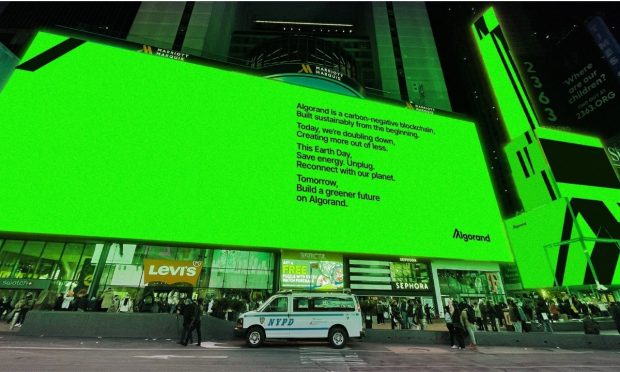Ethereum-Killer Algorand Blacks out Times Square to Celebrate Going Carbon Negative

One of the Ethereum-killer blockchains is betting that its green footprint is an advantage that it can use to woo developers and investors away from the original smart-contract cryptocurrency.
On April 21, Algorand celebrated Earth Day by announcing that it had introduced a smart contract that will ensure that the carbon footprint of every transaction is offset without any action by the people or companies making them.
Instead, a portion of the network fees collected by the blockchain have been permanently directed into buying carbon credits through ClimateTrade, a CO2 emissions marketplace that tracks offsets on a blockchain — Algorand, of course — so that they are permanently and publicly available to corporations looking to erase their footprints.
And to make that point, the company bought out — and blacked out — nearly 20 of Times Square’s iconic billboards on Earth Day.
Going Negative
“We are turning off Times Square for an hour so everybody can just take a pause and reflect for an hour on the importance of mother earth,” Algorand Foundation CEO Staci Warden told PYMNTS. “Now it also happens that we are able to translate the power usage of Times Square because they’re very progressive — Times Square was founded on the arts community, so they care a lot about it.”
That lets the Foundation calculate the number of transactions that hour of power offsets. “With the energy that Times Square uses, we can do 350 million transactions,” she said. “That means 350 million payments.”
Pointing to blockchain’s potential to make payments processing faster, cheaper and more scalable, Warden said that would take the current SWIFT payments messaging system about a month to handle.
“350 million payments over Algorand, which is 24/7, takes about 90 hours,” she added.
That carbon offset becomes a bigger deal when you think about payments, she said.
Scale Matters
“When I think about payments, I think about financial inclusion,” Warden said. Pointing to the 1.7 billion unbanked people in the world that many blockchain projects seek to bring into the global financial system, she added, “Payments are the bedrock of everything. It’s where you establish credit, where you establish savings, where you establish insurance — all of the better and more robust financial products start with payments.”
If you’re going to think on that scale, Warden said, “You’d better make sure you’re carbon negative. That’s something that, I think, investors are looking at more and more these days, too — not just ESG, but also the public.”
Read more: Bitcoin’s New Headwind: ESG Investors Double Down on Its ‘Staggering’ Pollution
Algorand is one of number of blockchains pitching itself as a better mousetrap for crypto projects ranging from decentralized finance (DeFi) and non-fungible tokens (NFTs) to micropayments, in part because its proof of stake (PoS) blockchain uses a tiny fraction of the country-sized electric bill both Bitcoin and Ethereum, the No. 1 and No. 2 blockchains, suck down every year.
Just Say No
That has become a bigger and bigger problem, even beyond the ESG investors who focus on environmental-, social- and governance-friendly companies.
The issue came to a head in the European Parliament last month, when an effort by EU green parties to write a ban on power-hungry, proof of work (PoW) blockchains — which would have amounted to de facto ban on bitcoin — came fairly close to succeeding on being incorporated into a draft of the new Markets in Crypto Assets (MICA) rules until a fairly aggressive lobbying and publicity campaign helped push it back.
Related: EU Parliament Votes Against Crypto Mining Ban
While the Ethereum blockchain is also PoW, it is in the process of transforming into a PoS chain. But the often-delayed project is not scheduled to turn off the bitcoin-style mining consensus mechanism — which both secures PoW blockchains and writes new transaction blocks onto them — until next year at the earliest.
This means that until then, it will remain dirty, very slow (12-14 transactions per second) and overburdened with so many transactions that fees are in the dollars range, at best.
Read more: Ethereum 2.0 Will Not Be Any Faster, Vitalik Buterin Said. But It Will Still Scale Massively
That gives the far more scalable Ethereum-killers, with fees ranging from pennies to fractions of a penny, a lot of time to attract projects and developers who want the greener footprint and greater scalability.